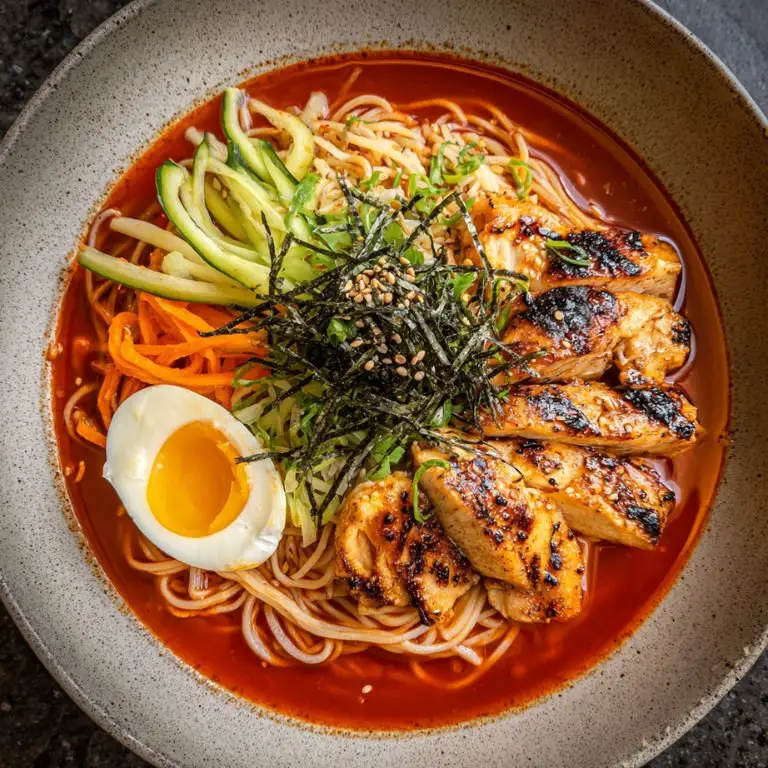There’s something about bibim guksu that just hits different. Maybe it’s the fiery kick of gochujang, or the way the cold noodles tangle around tender strips of spicy chicken, or how every bite feels like a dance between sweet, spicy, and sour. This isn’t your average noodle salad — it’s a flavor-packed Korean dish that’s fast becoming a staple for anyone craving something bold, vibrant, and ridiculously satisfying. If you're exploring authentic korean recipes or just looking for korean easy recipes that bring maximum impact with minimal effort, this spicy chicken bibim guksu will blow your expectations out of the water.
Perfect for a quick weeknight dinner, especially during warmer months, this dish is cool, spicy, and refreshingly light. It's a great introduction for those wondering how to make Korean noodles with depth and character. Plus, it’s visually stunning — a true example of that irresistible Korean noodles aesthetic. Let’s break it all down.
Spicy Chicken Bibim Guksu
Prep Time 15 minutes mins
Cook Time 20 minutes mins
Total Time 35 minutes mins
Course Main Course
Cuisine Korean
Medium saucepan (for boiling noodles)
Frying pan or skillet (for cooking chicken)
Mixing bowls (for sauces and tossing)
Cutting board and sharp knife
Tongs or Chopsticks (for tossing noodles)
Grater (for pear or apple and ginger)
For the Chicken
- 1 lb boneless skinless chicken breasts or thighs (thighs are juicier, but breasts work too)
- 2 tablespoons soy sauce
- 1 tablespoon sesame oil
- 1 tablespoon gochujang Korean fermented chili paste
- 1 tablespoon rice vinegar
- 1 tablespoon honey
- 2 cloves fresh garlic minced
- 1 teaspoon grated ginger
- 1 tablespoon vegetable oil for cooking
For the Bibim Sauce
- 3 tablespoons gochujang
- 1 tablespoon rice vinegar
- 2 tablespoons soy sauce
- 1 tablespoon sesame oil
- 1 tablespoon honey or sugar
- 1 tablespoon grated pear or apple adds natural sweetness
- 1 teaspoon minced fresh garlic
- 1 teaspoon toasted sesame seeds
For the Noodles
- 8 oz somyeon thin wheat noodles, soba, or even angel hair pasta as a substitute
- Ice water for rinsing noodles post-cook
Garnishes
- Julienned cucumber
- Shredded lettuce or napa cabbage
- Julienned carrots
- Thinly sliced scallions
- Soft-boiled egg halved
- Toasted sesame seeds
- Seaweed flakes optional
- Kimchi on the side, optional
Marinate the Chicken
In a bowl, combine soy sauce, sesame oil, gochujang, rice vinegar, honey, garlic, and ginger. Mix well. Add chicken breasts/thighs, coating them thoroughly. Let them marinate for at least 15 minutes — or longer if you have time.
Cook the Chicken
Heat vegetable oil in a skillet over medium-high heat. Add the marinated chicken and sear until fully cooked and slightly charred at the edges — about 6-8 minutes per side. Once cooked, let the chicken rest for 5 minutes before slicing into thin strips.
Prepare the Bibim Sauce
In a bowl, mix together gochujang, rice vinegar, soy sauce, sesame oil, honey, grated pear, garlic, and sesame seeds. Taste and adjust: want it sweeter? Add a dash more honey. Want more tang? Extra vinegar. Set aside.
Cook the Noodles
Boil noodles according to package instructions (typically 3-5 minutes for somyeon). Drain and immediately rinse under very cold water or dunk into an ice bath. This halts the cooking and gives that chewy, refreshing bite.
Toss It All Together
In a large mixing bowl, combine the cold noodles with the bibim sauce. Toss well until every strand is coated in spicy, tangy goodness. Add the sliced chicken on top, along with your desired garnishes: cucumber, carrots, greens, scallions, and soft-boiled egg.
Serve
Plate the noodles in shallow bowls, top with chicken and veggies, and sprinkle extra sesame seeds or seaweed flakes. A side of kimchi never hurts. Serve immediately — cold and spicy!
Pairings
This spicy chicken bibim guksu plays well with several accompaniments:
- Banchan (Korean Side Dishes): Think pickled radishes, seasoned spinach (sigeumchi namul), and of course, kimchi.
- Broth or Soup: A light, chilled korean noodle soup (like dongchimi guksu) can balance out the spice beautifully.
- Drink Pairings: A cold barley tea (boricha), or even a light lager or soju for a more festive touch.
- Dessert: Something cold and mild, like Korean melon or a small scoop of yuzu sorbet, keeps the palate refreshed.
This dish works beautifully as a standalone meal or as the centerpiece for a larger Korean-inspired spread.
FAQs
1. What kind of chicken works best for this recipe?
Boneless, skinless chicken thighs are ideal because they stay juicy and flavorful. However, you can use chicken breast if you prefer a leaner cut — just be careful not to overcook it.
2. Can I make this vegetarian or vegan?
Absolutely. Swap out the chicken for tofu or mushrooms (oyster mushrooms sautéed with garlic and soy sauce are amazing). Just ensure your gochujang is vegan, as some brands include anchovy extract.
3. Can I use different noodles?
Yes! While somyeon is traditional, korean instant noodles or even korean pasta-style noodles work. For something chewy and glassy, try sweet potato starch noodles used in japchae — a korean noodles recipe that’s always a hit.
4. How spicy is this dish?
It’s moderately spicy — gochujang gives a deep, fermented heat rather than a raw burn. You can dial up or down the spice by adjusting the amount of gochujang in the sauce and marinade.
5. How far in advance can I make this?
The chicken and bibim sauce can be prepared a day ahead. Cook and rinse the noodles just before serving to maintain that perfect texture. Leftovers are okay the next day but best enjoyed fresh.
